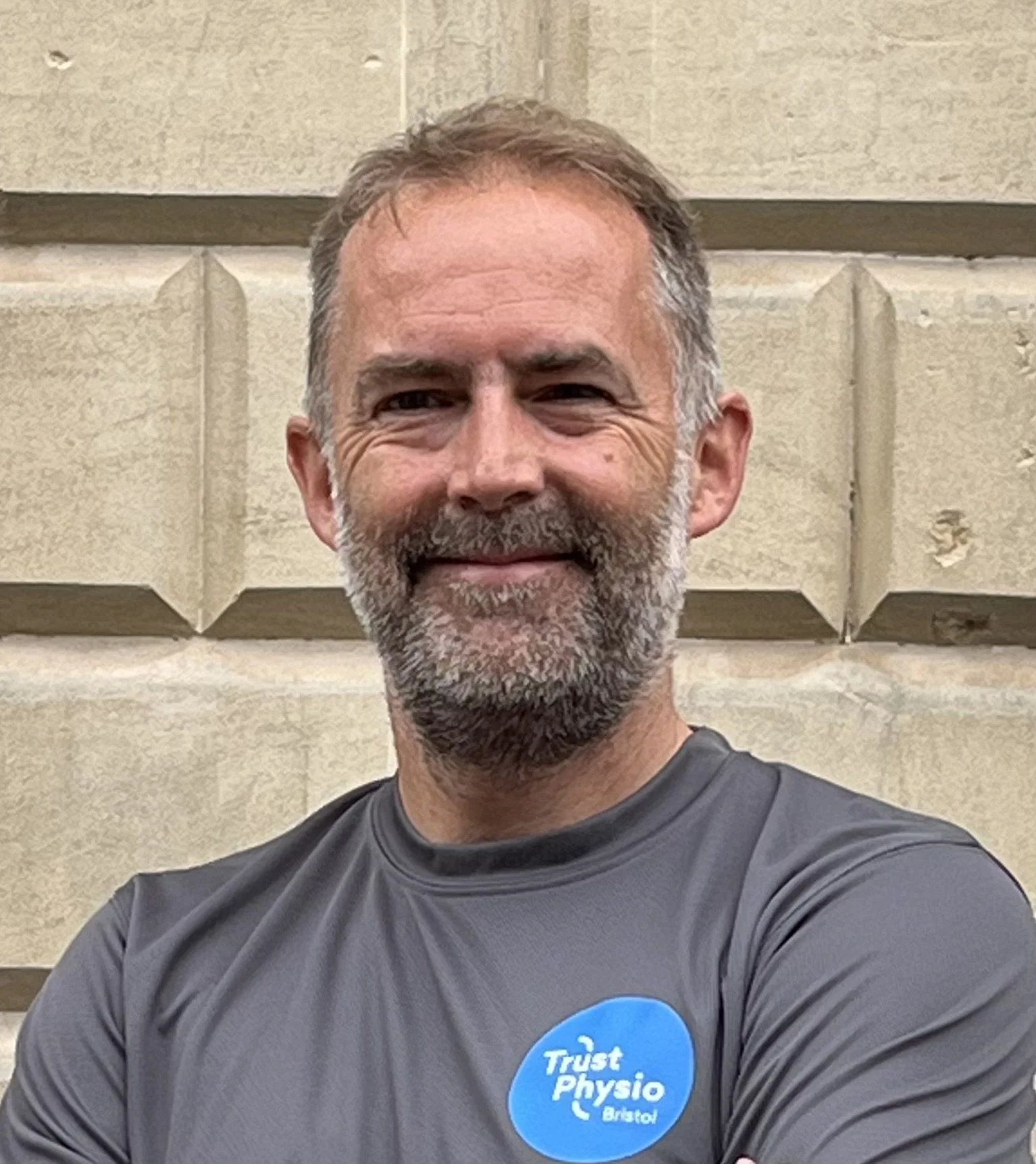Trust Physio Bristol
Physiotherapy for Runners
Physio Advice for Running
This guide will provide you with advice on common running injuries, running prehabilitation, running posture and a special focus on “super running shoes”.
Running Information Sheet
Five most common running injuries according to a 2012 paper by Dias Lopes et al - Achilles Tendinopathy, Plantar Heel Pain, Shin Splints, Patellofemoral Pain, Iliotibial Band Pain.
Common Injuries:
a) Tendinopathies
Common sites: achilles, hamstrings, peroneal (outside of the lower leg), patella (knee)
Symptoms: pain on loading, morning stiffness, unpredictable
Causes: step change in loading, weak muscles, unsuitable
footwear
b) Plantar Heel Pain (a.k.a. Plantar Fasciitis)
Common sites: medial arch of the foot
Symptoms: Pain (sharp, burning) in the arch of the foot, worse first thing in morning.
Causes: increase in training volume, change of surface/shoes, overloaded calf muscles.
c) Shin splints (a.ka. medial tibial stress syndrome)
Common Sites: front of shin
Symptoms: pain on loading, localised swelling
Causes: step change in loading, footwear, incline of surface
d) Runners Knee (a.k.a. patella-femoral joint pain)
Common Sites: under the knee cap, in the patella tendon
Symptoms: pain with ascending/descending stairs, squats, pain
after running, sitting with knees flexed.
Causes: tight IT Band, short quads, weak hams, lateral pelvic
instability caused by poor recruitment of gluteal muscles.
e) Iliotibial band (ITB) syndrome
Common Sites: outside of the knee and hip (especially in women).
Symptoms: sharp pain/ache spreading up/down outside of thigh,
usually only when running or cycling, may linger afterwards.
Causes: Lateral pelvic instability caused by poor recruitment of
glutes, tightening/drying out of the fascia in the ITB.
Prehabilitation:
Eccentric strengthening of Hamstrings and Gastroc/Soleus.
Concentric strengthening of quadriceps and hip flexors.
Activation of gluteal and abdominal muscles (stability muscles) in functional positions.
Stretching and foam rolling hip flexors, quadriceps, hamstrings and Iliotibial band.
Balance work on both legs to activate and strengthen ankle stabilisers.
Posture:
Aim to keep your ears, shoulders and hips in line.
Leaning forwards will create tension in the muscles on the back of
your body and tension is the enemy of efficiency, and running is an
efficiency sport.
Your spinal discs, ligaments and muscles from your feet to your
head provide elastic recoil, and this will be greatest when your
joints are in the mid range.
Angel/Zombie posture:
Extend your arms in front of you [like a zombie] and walk - you will
notice that because your centre of gravity moves forwards, you
need to fling your feet out in front of you to stop falling over, this
increases heel strike, which is less efficient.
Extend your arms behind you [like an angel] and walk - you will
notice that because your centre of gravity moves forwards, you find
your feet striking the ground in the mid foot and importantly under
the hip, which is much more efficient.
You want to run with the mid forearms in the mid line of your body.
For most of us, that will shift our weight backwards, improving
efficiency. You will notice the biggest difference when you are
fatigued.
Why do we get cramp?
The cause of cramping is a bit contested, however the most sports scientists think of it as a neuromuscular malfunction in the reflex between the muscle and the spinal cord. The motor nerve simply overstimulates the muscle.
Causes:
Load exceeds capacity of the muscle.
Fatigue
How to stop it happening?
Strengthening the muscles.
Match your race pace to your training.
How to deal with it when it happens?
Stop and stretch it out without increasing the pain.
Heart Rate Training Zones:
Zone 1 (recovery/easy) 55%-65% HR max
Zone 2 (aerobic/base) 65%-75% HR max
Zone 3 (tempo) 80%-85% HR max
Zone 4 (lactate threshold) 85%-88% HR max
Zone 5 (anaerobic) 90% HR max and above
Carbon Fibre Running Super Shoes:
Basic principles:
The plate increases the bending stiffness of the shoe which shifts the centre of pressure to the front of the shoe.
This increases the lever between the ankle joint and the forefoot, while reducing bending at the big toe.
This reduces intrinsic foot and calf muscle load.
The curvature of the plate may rock the foot forwards, applying an upward force to the heel, thereby reducing muscle work in the calves.
The PEBAX foam is a responsive foam that when compressed returns up to 87% of kinetic energy to the push off.
This reduces the amount of muscle work required to absorb impact and propel the runner forwards.
The increased stack height also increases leg length allowing for longer stride length.
The low weight of super shoes reduces the energy required move the leg through swing phase.
Do they work?
Yes, the rocker effect of the carbon plate may reduce the muscle load on the intrinsic foot and calf muscles, the stack height may increase stride length and the responsive foam may return energy further reducing load on the intrinsic foot and calf muscles.
Studies show that these shoes reduce the energy cost of running by 4%, however other studies show that you can reduce the energy cost of running by 4% through increasing the tendon stiffness and muscular contractile strength of the calf muscles.
This is great for race shoes, but not for training.
If you reduce the loading on muscles and tendons in training, then you will effectively be weakening your calf and foot muscles and tendons.
Save the carbon shoes for race day and run without one in training, unless you are doing tempo training.

